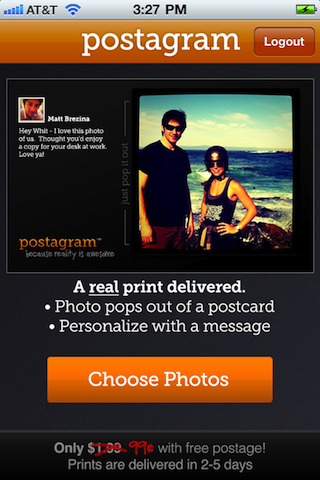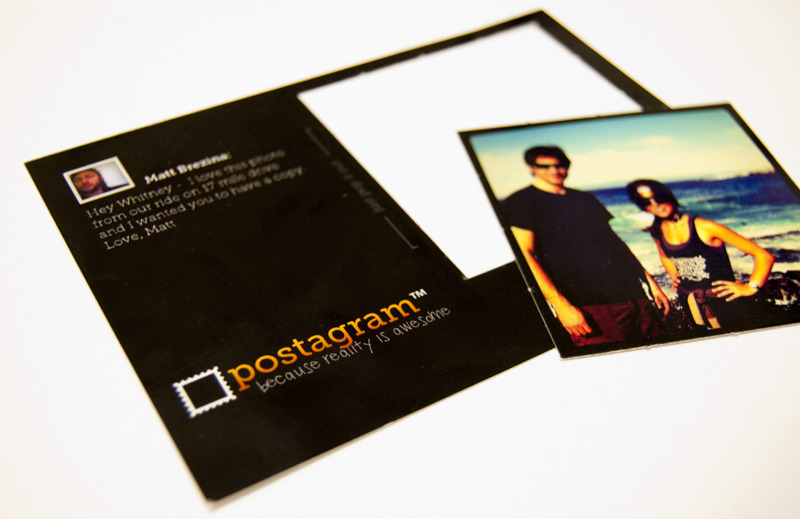Sincerely's Postagram is hot on the tails of Touchnote
Now then, I am a massive fan of photos-to-postcards service, Touchnote. The company has — more or less — owned the space for years. There’s a few upstarts enter the market only to flounder. One that caught my attention a little while ago was Shootit for BlackBerry, then Hippopost (I’m not sure what happened to that one), then — well, it’s actually quite easy to setup these kinds of services, the challenge is making them pay, and making it easy to do so.
One of my biggest issues with Touchnote is that the end-to-end process is a wee bit frustrating. I’ve wanted to press next-next-finish and have them bill my card or my account immediately. The check-out process on the iPhone app — my platform of choice for photos — is rather laborious.
However, Touchnote has got game. The company’s been around for years and they’ve been striking deals left, right and centre, most notably on the Android platform. Indeed, the company has been lauded by multiple device manufacturers to the point that Touchnote is embedded on (I think) millions of devices. I say, I think because I don’t want to get the figures wrong. And I’m not sure if the array of embed deals are public as yet. The Sony Ericsson deal is certainly public.
Whilst Touchnote has been heavily investing in Android (and, er, other platforms that I’m pretty confident they haven’t announced), the iPhone side of the company has, I think it’s fair to say, been left idling. That’s been a mite frustrating for me.
I’ve watched the rise of the photo apps on iPhone. From the Hipstamatics to the Instagrams and I’ve been waiting for someone to deal with ‘the last mile’ with these apps — that is, plug them into the physical world. I’d imagine that in the business plans of every photo-sharing-filter-app, there’s a section marked ‘monetisation’. In that section there will be numerous mentions of in-app billing, upgrades and proof-points demonstrating how the first iteration of photo apps made a good few million selling folk extra filters. There will also be a section marked ‘physical delivery’. It will point out that digital printing is a possible option and that, in the fullness of time, the company will seek to exploit that revenue option.
Hardly anybody has bothered.
It’s a bit, big market opportunity. You only need to look at the ‘Touchnote Wall’ in our kitchen housing all the photos that I’ve sent to grandparents, friends and relatives, mostly featuring our 1-year old boy, Archie. My policy? Whenever I’ve been sending a Touchnote, I ‘copy it’ to my wife — e.g., I pay to get one sent to her as well. It’s nice. I like it. And it’s dirt cheap.
It’s not actually dirt cheap: Touchnote costs £1.49 per card, however in the context of my son Archie — doting father that I am — I am liable to send Touchnotes like sweeties. Spending twenty-quid in a single 1am ‘shit, I need to send something to my great-grandmother’ session doesn’t bother me. The return-on-investment is nigh-on incalculable for me. No, let me put it another way, it’s irrelevant. I’d sooner spent a hundred quid a month on a Touchnote-habit than on a nice meal.
There’s a massive, massive opportunity out there for these photo-sharing companies. Most of them have completely missed the boat. Once you’ve taken the photo of your friend wearing over-sized sunglasses and applied three types of filter, now you need to DO something with it. Yes, whack it to Twitter. Yes, copy it to Facebook. By all means, stick it on Tumblr. But what about posting it?
Ask anyone, they’ll say “Wicked, great idea, let’s do it.”
Then they’ll say, “How much?”
That’s the key issue.
£1.49 is expensive on first glance. It’s terribly expensive if you’re a 21-year-old worrying about having enough phone credit. It’s crazily expensive for a 16-year-old. It is peanuts for a 34-year-old with a recently arrived baby and a pile of grandparents wanting pictures every week.
So that’s your market. That’s the market this kind of thing. That’s where there’s inelastic demand. There is a segment of the 200 million iPhone population, perhaps it’s maybe a few million strong, where each person has an iPhone 4, earns £50-100k+ and has an inelastic requirement to send photos as postcards to grandparents (along with friends and other relatives) regularly.
It’s with no small amount of excitement then that I read about the introduction of the Postagram App recently from the team at recently formed Sincerely. Postagram will print your Instagram photos for $1.98 anywhere in the world. Or, $0.99 for (I presume) a limited time. The app looks fantastic, the service looks impeccably Silicon-Valley (i.e. beautifully rendered, excellent UI, smooth payment process). But it needs Instagram. That’s their go-to-market strategy. You can’t send photos from your iPhone with the service right now. You need to have uploaded the photos to Instagram first and then you can select it and send it from Postagram.
The service has nothing whatsoever to do, legally, with Instagram. Yet. I suspect it probably took about 0.8 seconds for the Instagram team to process the obvious when the Postagram announcement hit the airwaves. Instagram has a pile of cash, expectant investors, a bucketload of competition and, I suspect, a reasonable interest in the additional revenue stream offered by physically delivering photos. Instagram buys Postagram? Who would be surprised? What would Instagram do if the team from Hipstamatic were seen at the First Round Capital offices? Or if Kodak’s people were rumoured to be ‘in talks’?
I haven’t had the opportunity to use Postagram yet as it’s only available in the US App Store right now. I did give some thought to using my US iTunes account to download it. But no. I shall be patient.
The Postagram team hail from inbox-management service Xobni, so they have game too. And they’re based in the Valley, where everything runs at light speed.
As of this week, there’s now an Android version of Postagram and the iPhone app has now gone to version 2.0. That’s a 7-week iteration for the latest iPhone version. Co-founders Matt and Bryan certainly mean business. This latest version enables users can now grab photos from Facebook, their device album library and the device camera.
From the looks of it, the end-to-end process with Postagram on the iPhone appears to be rather smooth. My wife had a look at the site’s app animation illustrating each stage and immediately reached to download the app. She’s been after something with a really easy check-out process for her iPhone 4 for ages.
Although the strategies followed by both Postagram and Touchnote are slightly different it’s rather difficult not to compare and contrast their offerings. It’s going to be rather exciting seeing what both companies deliver into the market over the next few months.
Whilst we wait, here are a few screenshots of Postagram:
And by the way, here’s a video (courtesy of GigaOM) of Sincerely co-founder, Matt, providing a quick overview:









